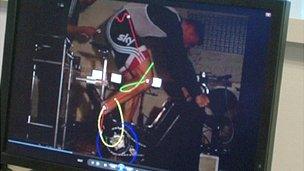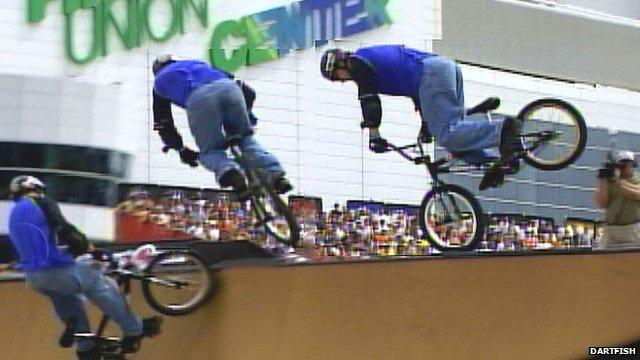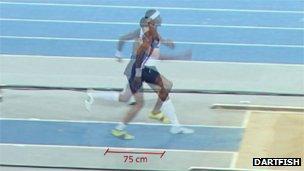Olympics 2012: Video analysis software powers Team GB
- Published
Performance Analyst Stafford Murray explains the software powering Team GB
"Someone kept kicking the power lead out of my camera", says Stafford Murray with a wry smile. "I'm pretty sure it was a rival analyst."
The camera was stuffed in his jacket at a squash tournament in Holland. It was about 20 years ago, says Mr Murray, when performance analysts like himself were a rare breed and the work was a clandestine activity.
Going to sporting events with your camera and laptop was seen as a strange thing to do, he says. Governing bodies didn't like it, opponents and their coaches were wary of it. So analysts competed with each other on the sly.
"Back then, analysis was done in the coach's mind, it was all subjective", says Mr Murray. The problem is, typically coaches can only remember about 30% of an athlete's performance, limiting feedback.
Video analysis is now essential to the modern athlete's training, and most work with an analyst as well as a coach.
As we walk down the corridor to his office in the English Institute of Sport in Manchester, a series of athletes catch Mr Murray's eye, from stout rugby players to lean sprinters.
Heading a team of 25 performance analysts, he is involved in training a spectrum of Olympic athletes. Today he wants to show off the back-room team working with British Olympic cyclists.
"Traditionally in sport science we talk about 1% making the difference between winning and losing," says Mr Murray. "But these days it's one thousandth of one per cent. So software allows us to measure that piece of information that will make the difference between medal, and no medal. It can recall information that the eye can't see."
Mr Murray introduces Paul Barratt, biomechanist for British Cycling, who is at work with Quintic software, one of the off-the-shelf products used by Team GB.

Quintic software analyses "joint specific" power output
He shows on his computer slow-motion video of a cyclist pedalling in a gym. Fixed bright markers emanate from his limbs, creating hypnotic spirals.
High-speed cameras recording 300 frames per second are trained on the cyclist, says Mr Barratt. Reflectors are fitted to the pedal, the fifth metatarsal joint on the foot, and the centres of the ankle, knee and hip joints.
As the cyclist pedals at full pelt, the movements of these points are recorded.
Quintic tracks and digitises automatically frame by frame the markers, so the position, velocity and acceleration data of the cyclist's individual joints can be measured and analysed in great detail.
This analysis is fed back to the coach and cyclist, and basic things like seat and handlebar height can be changed, to alter the posture, and improve the performance, says Mr Barratt.
The ambition is not new, just the technology. In the 1970s the same feat was attempted using cine-cameras, says Murray. Footage was projected onto a white wall, on a stop-frame basis, and limb positions were physically marked with a pen by hand, creating a constellation of dots. It was a painstaking process, and whole PhDs could be written on one case study.
Software has just vastly speeded up the process.
Mr Murray then introduces Will Forbes, performance analyst for British Cycling, who is working with Dartfish software.
Designed to work with live video feeds, it can help during competitive matches.
Developed by the Swiss Institute of Technology in Lausanne, it has been picked up by international sports bodies like the US Olympic Committee, football clubs like Manchester United, and also broadcasters. The BBC used Dartfish for its <link> <caption>coverage</caption> <url href="http://news.bbc.co.uk/sport1/hi/other_sports/winter_sports/4603454.stm" platform="highweb"/> </link> of the 2006 Winter Olympics.
Mr Forbes demonstrates the StroMotion feature. It breaks down complex actions like a javelin throw, or a run-up to a high jump, into a series of static moments that unfold through video, like a stroboscope.

Dartfish software: StroMotion function breaks down an athlete's performance frame by frame
If an athlete wants to be reminded of their best performance, the video clip can be stored on a cloud server, says Mr Murray, to be streamed to a coach's smartphone or tablet trackside, providing a constant video reference.
But it is the Simulcam, or "ghosting", feature that really excites Mr Murray.

SimulCam allows two performances to be compared
"It allows us to overlay two separate performances, to either look at ourselves twice to see where we we're losing time, or making it up. Or we can compare ourselves to our key opponents in the same way."
He loads up a cycle race in a velodrome. The British bike leaves a blue trail behind it, like in the film Tron, and you can clearly see how the opponent, with a red trail, has previously taken a different route around the track.
With force sensors on the pedals, more detailed information can be synchronised and loaded up onto the screen.
"The beauty of the software is that we can make changes during the actual performance as opposed to afterwards," Mr Murray says. So in the case of cycle team sprints, where there are breaks between races, it might affect gear selection, or the angle of attack round the bend.
Performance analysts will have to do a bit more exercise at these Olympics.
They will have access to the Olympic broadcast feed from a dedicated IT hub. But strict copyright rules mean they will not be allowed to wirelessly transfer footage to coaches at events, as they normally do.
Instead they will have to make DVDs at the hub, or do their own filming at events and export files onto hard disk, before transferring their software-inspired revelations by hand to coaches - relay race style.
Accredited analysts will have dedicated areas to film in Olympic venues.
It is all a far cry from the days when performance analysts hid cameras and laptops under their jackets. And at the 2012 Olympics, it could be their patient work with pixels that means the difference between Olympic agony, and glory.
- Published26 July 2012
- Published18 July 2012
- Published22 February 2012